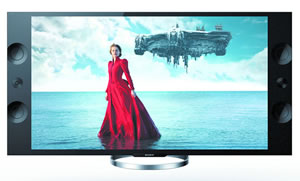The Skinny On Ultra HD 4K TVs
As you may have heard, almost all the major TV manufacturers recently began shipping or are preparing to ship their own iterations of Ultra HD (aka 4K) televisions.So why is it called Ultra HD 4K? With a resolution of 3840 x 2160, it is quadruple the resolution of today’s HD 1080 televisions. In theory, this means more details, a sharper looking display, and it allows for much larger TVs that don’t look “soft.”
The higher pixel count enables images to go larger before they break up, which suits the larger TVs. Ultra HD is already in the realm of digital cinema, as most major Hollywood movies and TV shows are filmed in 4K, or even 5K. Ultra HD already began broadcasting in Europe in January 2013 via the EUTELSAT 10A satellite. The BBC has plans to film upcoming documentaries with 4K equipment, particularly the filming of Survival. South Korea is currently the leader in Ultra HD broadcasts, as its Kwanak Transmitter uses Digital Video Broadcasting-Second Generation Terrestrial (DVB-T2) architecture to send an Ultra HD signal compressed with High Efficiency Video Coding (HEVO) encoding.
Although 4K is barely in the mainstream market, there already are different tiers of these TVs available for you to purchase. The Chinese brand Seiki released a 50-inch 4K monitor for $1,000, and ASUS has a 31.5-inch model on the market for $3,500.
Of course, at the top of the tier is Sony’s 65-inch model for $7,000 (or 55-inch for $5,000). In support of its recent launch of 4K HD TVs into the market, the company integrated a marketing campaign that features Garth Davis (who co-directed Jane Campion’s critically acclaimed mini-series Top of the Lake) to celebrate.
Sony’s focus on 4K is the first piece of a yearlong campaign that showcases emerging and established collaborators who have been inspired by Sony technology to create unique and unforgettable stories and Sony brand experiences. You can view the broadcast spot here: youtube.com/watch?v=RhcvCZtNW9s. The release of this TV is almost perfect timing with the near-future release of the PlayStation 4 (PS4). If you buy the TV now, you’ll be used to it by the time the PS4 comes out.
Unfortunately at the moment, 4K content is extremely limited. Most of the computers out there today even have a difficult time displaying 4K. Only the latest, greatest and fastest video cards can handle the 4K resolution.
So, you wonder, how do you watch Ultra HD films on your wonderful Ultra HD TV? The first generation Ultra HD TV owners will have to rely on content delivery systems, such as a server. Additionally, you can use the REDRAY PLAYER, which is the first plug-and-play friendly device that is capable of providing 4K content to 4K displays. It can also upscale HD files to the Ultra HD resolution. This little innovation will cost you $1,750. For now the mainstream market will be about upscaling the resolution, and it’s difficult to say when Ultra HD will become the standard.




